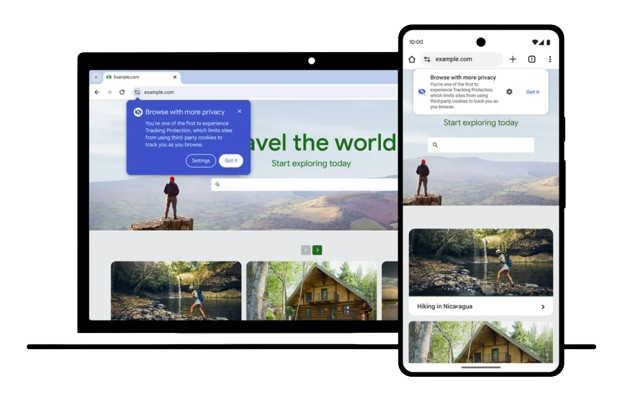Media
What does it mean for marketers?
New year, new move into the next phase of a privacy-first future. On the 4th of January, Google’s latest test, Tracking Protection was rolled out. This is a key milestone in Google’s initiative to phase out third-party cookies for all users in the latter half of this year (Q3).
What is Tracking Protection?
It’s a brand new feature from Google which limits cross-site tracking by restricting website access to third-party cookies by default.
Who does it affect?
Google has rolled this out to 1% of Chrome users globally. Starting with this small test base allows developers to measure whether they are ready for a web without third-party cookies.
Where do I find Tracking Protection?
If you’re part of the 1%, you will see a notification pop up in your browser as shown in the example below. As you search the web on desktop or mobile, third-party cookies will automatically be restricted, limiting the ability to track you across the websites you visit.
As Google ramps up its privacy measures, for those who are currently heavily dependent on third-party cookies, there is no better time to prepare. It is important to future proof your marketing and rethink how your data is processed. Here are a few ways you can do this:
-
Leveraging 1st party data AND zero party data.
If you’re not already, it’s crucial to collect first party data. If you already have it, now is the perfect time to revisit what you’re collecting and enhance it. 1PD includes valuable email lists collected from users by creating an account, signing up to a newsletter or being the first to know about an upcoming sale.
Sources suggest Zero party data is a term coined by Forrester Research – it refers to data that a customer proactively chooses to share with you. This can include the likes of:
- Preference centre information
- Purchase intentions or contexts
- Details about how the user wants a brand to recognise them
This pool of data, combined with your 1st party data, has increased value because it shows clear user intent, ever more important as we ride the wave to a privacy-first future. Utilising this data in your marketing campaigns is crucial; learning about your audiences’ wants and needs allows you to adapt your messaging and creative to create a winning formula they will engage with.
2. Walled Gardens
Next up, walled gardens. Walled gardens are platforms with closed systems that are able to control data across their ecosystem. Examples include the likes of tech giants, Google, Amazon and Meta, each of which offer a very convenient all-in-one hub for us as marketers/advertisers.
Why are they beneficial?
For us, in the advertising world, walled gardens are valuable as they are able to deliver large amounts of data, inventory and audience information, all of which is regularly updated and fully compliant. This allows us to use it in our activity to execute highly targeted, advanced campaigns with the reassurance we are not violating any data privacy policies.
What’s the catch?
Well, there is a downside to walled gardens. Highly valuable data comes at a cost. That cost is the loss of control and transparency when measuring your performance. This is due to the fact the data within walled gardens stays in the walled garden. As a result we only get aggregated performance data. In essence, it’s about striking a balance. Yes you get access to well developed campaigns but all at the mercy of not actually being able to understand your audience as much as you’d like, meaning you’re not getting the full picture.
3. Google Topics API
Google has developed a new approach to interest-based advertising. They first created the Federation Learning of Cohorts (FLoC) back in 2021. The Topics proposal in the Privacy Sandbox, evolved from FLoC, based on input from the web community and learnings from this initial trial.
Topics was designed to retain privacy but still show relevant content and ads to its users. They are categories of interest, assigned to a browser based on recent user activity. These topics can supplement contextual information to help select appropriate advertisements.
How does it work?
There are two parts to Topics:
- Google labels websites from a set of recognisable, broad topics. For example, a user’s browser would match a beauty website with the topic “Beauty”. Then, the browser collects a few of the most frequent topics associated with the websites that a user has visited. These are then shared (one new topic per week) with the sites they visit to help us as advertisers show more relevant ads.
- The browser will use a limited set of topics (around 400) hand selected by real people in a publicly visible list. The list does not include sensitive categories and Google will limit the taxonomy’s size to reduce the risk of fingerprinting.
4. Stay in the loop
Stay up to date with the latest developments so you can adapt early. As we roll into the next few months, we recommend you keep abreast of the latest privacy practices that may impact you and your business; Google’s Privacy Sandbox provides a timeline to help you to prepare in good time.
As always, we recommend you strive to build a connected measurement ecosystem, prioritising first-party data collection while leveraging powerful tools like Google Enhanced Conversion and Meta Conversions API within walled gardens. When used alongside technology like a Customer Data Platform, this combination allows you to build rich audience profiles, tailor segments, and activate them across platforms, delivering highly personalised messages at the right time.
